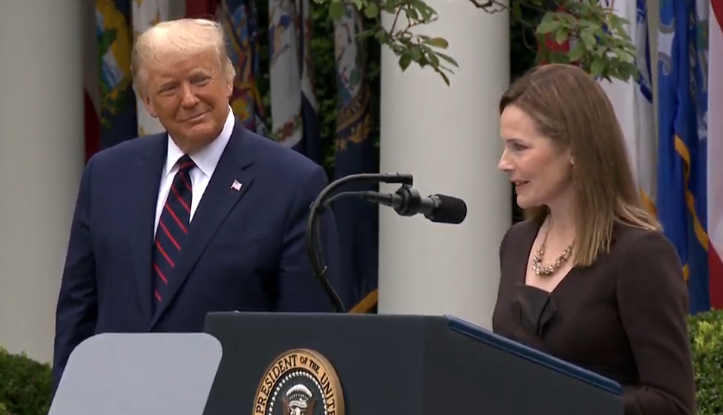President Donald Trump has made his choice to replace the late Ruth Bader Ginsburg to the Supreme Court — and it is Judge Amy Coney Barrett, who currently serves on the Seventh Circuit Court of Appeals, clerked for the late Antonin Scalia and shares his textualist philosophy of constitutional and legal interpretation.
Barrett is therefore a highly qualified jurist, and also one of the nation’s foremost legal minds on the Constitution — and on upholding the meaning of its words in federal courts. She will serve the Supreme Court — and the nation — well in that regard. The Constitution always needs more defenders.
In her review of Randy Barnett’s “Our Republican Constitution,” Barrett outlined a strong defense of originalist interpretation of the Constitution and of the law, urging “fidelity to the original public meaning”: “The measure of a court, then, is its fidelity to the original public meaning, which serves as a constraint upon judicial decision making. A faithful judge resists the temptation to conflate the meaning of the Constitution with the judge’s own political preference; judges who give into that temptation exceed the limits of their power by holding a statute unconstitutional when it is not.”
But the basis for originalism and textualism has less to do with judicial restraint than with deference to the supreme law of the land, the Constitution: “The Constitution’s original public meaning is important not because adhering to it limits judicial discretion, but because it is the law. And because it is the law, judges must be faithful to it.”
What higher calling is there for a judge to fulfill? The rule of law is the cornerstone of constitutionally limited government, without which arbitrary and tyrannical rule could quickly take root. Barrett will safeguard the Constitution and the rights and liberties of all Americans.
And when a law conflicts with the supreme law, it must be held to be unconstitutional, upholding Marbury’s command for judges to “say what the law is”. Barrett writes, “At the same time, fidelity will inevitably require a court to hold some statutes unconstitutional. When a statute conflicts with the Constitution, the fundamental law of the Constitution must take precedence, and the ordinary law of the statute must give way — because, properly understood, it is not law at all. A court does not overstep simply by holding a statute unconstitutional; it oversteps if it does so without constitutional warrant.”
This is as strong a foundation for a judge as we have seen nominated in the past, and at just 48 years old, Barrett will undoubtedly serve for a good long while. This may be Trump’s strongest choice for the Supreme Court — not to take anything away from Justices Neil Gorsuch and Brett Kavanaugh, who each have their own strengths — but Barrett’s philosophy of law and the Constitution, as well as her stated duty to interpret the law as written could be a gold standard by which all other nominees should be judged. She’s that good.
Which is why confirmation should be relatively easy for both Senate Judiciary Committee Chairman Lindsey Graham (R-S.C.) and Senate Majority Leader Mitch McConnell (R-Ky.) to get through this year — before the election. The first hearings have been set for Oct. 12, leaving more than enough time to complete the process by the end of October.
Politically, a rapid confirmation process makes all the sense in the world for Senate Republicans and President Trump. Leaving the confirmation up in the air would be used by the opposition Democrats to drive voting turnout against the President, whereas getting Barrett seated before the election leaves no mistake that Trump’s greatest legacy on the judicial branch is to leave the Supreme Court with a solid constitutionalist majority — the way it should be.
Democrats and the Biden campaign, hoping that a win by former Vice President Joe Biden could somehow enable them to replace the seat with a Ginsburg clone will be dashed — because the seat will already be filled before a single vote is counted, something that could demoralize Democrats on the eve of the election.
Also, considering the possibility of a closely contested election, a fully represented Supreme Court will be needed to prevent an uncertain 4-4 outcome on an issue that might ultimately determine the outcome of the election, like in Bush v. Gore in 2000. Amy Coney Barrett could very likely be a tie-breaking vote in order to ensure that votes are counted with equal protection of the laws as required by the 14th Amendment in a state where the counting of absentee ballots could go awry, for example.
President Trump has kept his promise to appoint justices of the Supreme Court, and judges of federal courts, who adhere to the original meaning and intent of the Constitution — some 218 and counting with up to 300 by the end of the year, a record for any single term in office. In just four short years, the composition of the federal judiciary is being transformed for a generation. Just imagine what four more years of Trump would hold.
Robert Romano is the Vice President of Public Policy at Americans for Limited Government.






